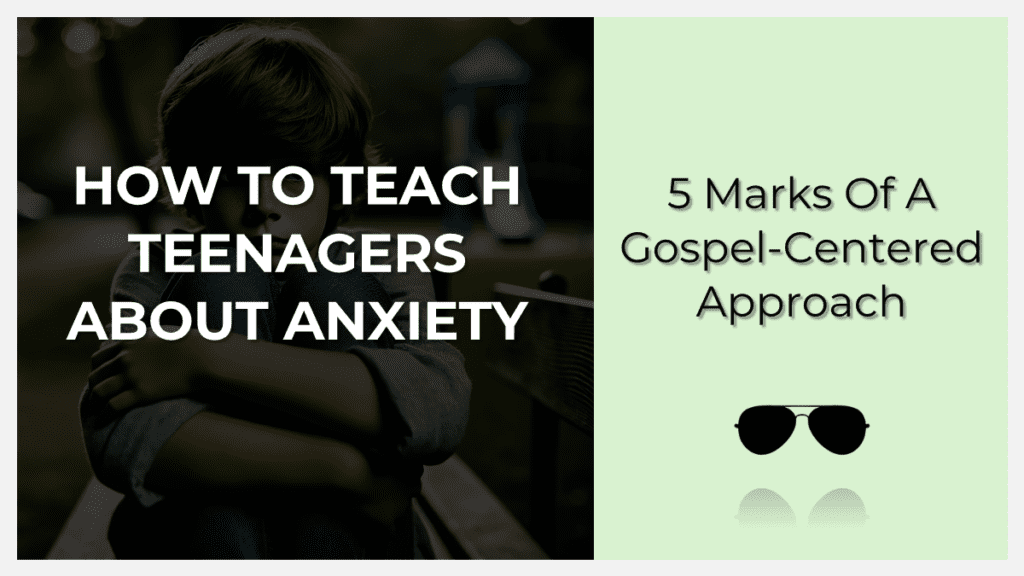
10 Youth Group Games You Can Play with Just a Kickball
Everyone loves games. Games can start connections with your group. As youth pastors, we want to make the time to

Anxiety is no longer just a personal struggle—it’s a generational crisis.
And they’re bringing those anxieties into your youth group. As youth pastors, we can’t just tell students to “pray more” or “stop worrying”—we need to give them biblical tools and real hope to navigate their anxiety. Here’s how to teach teenagers about anxiety in a way that is faithful, practical, and gospel-centered.
One of the biggest misconceptions about anxiety is that it’s a sign of weak faith. Students hear things like:
“If you trusted God more, you wouldn’t feel anxious.”
“Just pray about it and you’ll be fine. You must not have enough faith.”
“Christians shouldn’t struggle with fear.”
But the Bible is full of faithful people who battled deep anxiety.
David: “My heart pounds in my chest; the terror of death assaults me.” (Psalm 55:4)
Elijah: “I have had enough, Lord… Take my life.” (1 Kings 19:4)
Jesus: “My soul is overwhelmed with sorrow to the point of death.” (Matthew 26:38)
Anxiety isn’t a faith issue—it’s a human issue. When we acknowledge students’ struggles without making them feel spiritually inadequate, they’re more likely to trust us, open up, and seek Christ as their refuge. If we want to teach teenagers about anxiety, we need to ensure we’re creating a safe space.
Many students define themselves by their anxiety:
“I’m just an anxious person. I always have been.”
“I’ll always be like this.”
“This is just who I am.”
But anxiety is something they experience—not who they are. A student’s identity is found in Christ, not their struggles. So remind them they are not their anxiety—they are children of God. Help them see that Jesus doesn’t shame them for their struggles—He invites them to bring their burdens to Him. Encourage them to replace anxious thoughts with biblical truth. Because when students stop letting anxiety define them, they can start trusting God to lead them through it.
Telling students “Don’t worry” isn’t enough—they need practical, biblical tools to navigate anxiety in real time. Here are three powerful ways to help them fight anxiety:
1. The “Cast & Catch” Method (1 Peter 5:7)
“Cast all your anxiety on Him because He cares for you.”
Encourage students to write down their anxieties, pray over them, and physically throw the paper away as a symbol of giving it to God.
2. The “Peace Exchange” (Philippians 4:6-7)
“Do not be anxious about anything, but in every situation, by prayer and petition, with thanksgiving, present your requests to God.”
Challenge students to exchange anxious thoughts for gratitude by writing down three things they’re thankful for every time they feel overwhelmed.
3. The “Stillness Challenge” (Psalm 46:10)
“Be still, and know that I am God.”
Have students practice silence for 5 minutes each day—no screens, no distractions—just resting in God’s presence. When students learn to fight anxiety with biblical truth, they stop being controlled by fear and start living in the peace of Christ.
Today’s teenagers are facing new kinds of anxiety triggers that previous generations didn’t deal with.
Common Anxiety Triggers for Students:
📱 Social Media Comparison: The pressure to be “perfect” online.
📚 Academic Pressure: Fear of failure and future uncertainty.
💬 Relational Stress: Fear of rejection, friend drama, and loneliness.
🌍 World Events: Global crises, politics, and cultural anxiety.
If we ignore these realities, students won’t feel like the church understands them. So talk openly about modern stressors and how the gospel speaks to them. Help students set healthy boundaries with social media and school pressures. Create safe spaces for them to process their emotions without fear of judgment. Students need to know that Jesus doesn’t just care about their faith—He cares about their mental and emotional well-being too.
At the core of every anxious thought is a deep need for security. Students worry because they feel out of control. They feel encapable of handling it. Students feel afraid of the unknown, and unsure if they’re truly loved or accepted. But Jesus offers a peace that isn’t based on circumstances—it’s based on who He is.
The world’s version of peace says: “If everything goes right, then I won’t be anxious.”
Jesus’ version of peace says: “Even if everything goes wrong, I am still with you.”
That’s the hope students need.
When we teach teenagers about anxiety, we can’t promise students that following Jesus will make their anxiety disappear. But we can promise them this:
They aren’t alone in their struggles.
Their identity isn’t their anxiety. It’s found in Christ.
Jesus offers a peace that the world can’t give.
If we teach students to run to Jesus in their anxious moments, they’ll discover that real peace isn’t found in having control—it’s found in trusting the One who does. Looking for ready-made sermon series for your students on this topic? Check out Fractured, Veiled Heat, and Scrambled – Shop series designed to help students process stress, anxiety, and suffering respectively through a gospel lens.
Related Posts:
How to Teach Teenagers About Identity in Christ
How to Keep Students Engaged in Small Groups
For additional help choosing a curriculum that empowers you to disciple students effectively, explore our guide to choosing the best youth ministry curriculum for your church.

Everyone loves games. Games can start connections with your group. As youth pastors, we want to make the time to

Most of us don’t get into youth ministry for the overwhelmingly generous paycheck. We love Jesus, we love the next

The Trinity is one of the most foundational doctrines in Christianity—and one of the most confusing. How can God be